Secret Blue Mountains hiker group dividing local explorer community
They are an anonymous collective of hikers and take breathtakingly beautiful pics of the secret tracks, canyons and watering holes in the Blue Mountains. Tourism has surged off the back of their work, but not everyone is happy.
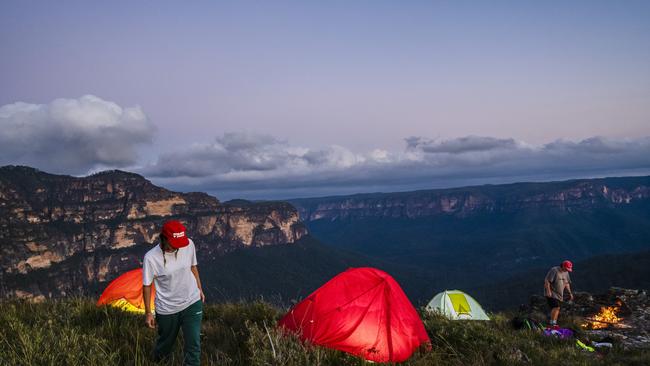
Sydney Weekend
Don't miss out on the headlines from Sydney Weekend. Followed categories will be added to My News.
Two young women stand atop a towering waterfall, 50m above the ground.
At the edge of the sandstone cascade is a small waterhole, a final place for the rushing water to collect before it tumbles off the soaring cliff face.
National Parks and Wildlife would prefer adventurers avoid this natural infinity pool altogether. The track to it is unmarked, the cliff edge unfenced.
At this height, the only thing separating visitors from life or death is less than a metre of slick rocks. Without a moment of hesitation the girls look at each other, throw their arms into the air, and jump off the slippery rocks, plunging into the rockpool.
Watching the scene, a man snaps a picture, grins, and saves it.
It will make a perfect Instagram shot, and will most certainly go viral. In a few days, weeks, or months, this otherwise forgotten patch of Blue Mountains wilderness will see a slow strand of visitors.
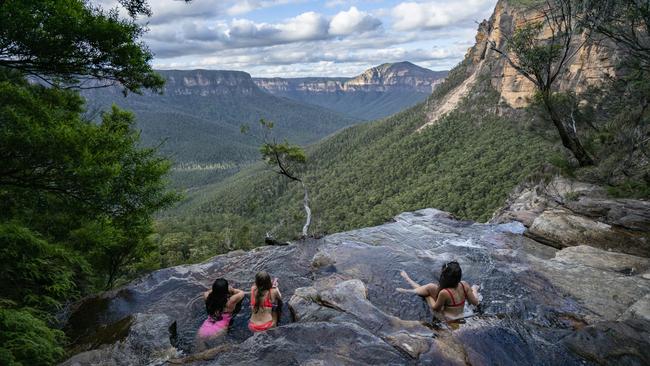
As the image traverses the feeds and timelines of Australian social media users, something will change. Likes will be replaced with hikes, screen time with green time.
The girls re-emerge from the frothing water and spray splashes over the cliff edge, the droplets falling to the deep canyon below. The moment is uploaded to Instagram, with the callout “epic cliff line waterholes (in the Blue Mountains) are everywhere, you just have to get outside and explore.”
The group’s job here is done.
The iconic mountain range to Sydney’s west holds an assortment of secrets. Secret waterholes, canyons, caves. Many of these places have been untouched for decades, eroded by time, existing only in folklore and the memories of long-time locals. There was a chance they would be forgotten altogether but an anonymous group of locals is helping share them with the world.
Some call them the Banksy of the Blue Mountains, others the Blue Mountain’s Batman. Officially they call themselves Lost Mountains, but no one knows who they really are. What locals do know, is that this group exists and they are changing the Blue Mountains, potentially forever.
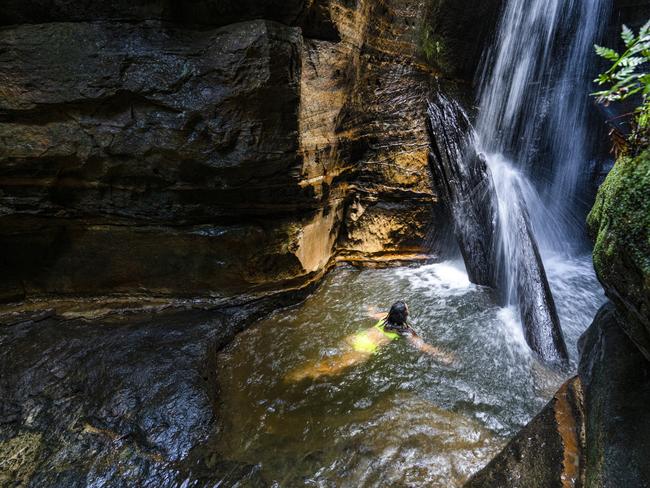
The group of 16 is on a mission to bring people into the national park, to highlight the hidden locations that would otherwise have been lost. After the Black Summer bushfires, Covid-19 pandemic and floods, the Blue Mountains community was on its knees.
Businesses dependent on tourism were suffering, and mental health was at an all-time low. From 2019 to 2021, it’s estimated the tourism industry lost $186m in revenue. For the first time, visitor numbers plunged – falling from 4.6 million in 2019 to 2.8 million in 2020. Unable to watch their community suffer, a band of friends – all lifelong locals and explorers – began posting images and videos of their favourite natural hideaways online.
It worked. The account exploded in popularity, with followers soon demanding a guidebook. They have more than 190k followers on Instagram (@bluemtns_explore) and their three guidebooks – “This Ain’t the City”, “Epic”and “Wild” – directing people to the secluded spots, have sold 50,000 copies. All this has contributed to the boom in tourism here with latest data showing 3.7m people visited the mountains last year. So successful has the community-led campaign been that former foreign minister Marise Payne publicly endorsed the work.
According to Payne, the team “has helped hit the reset button, to show tourists that the Blue Mountains is a safe and exciting place to visit”.
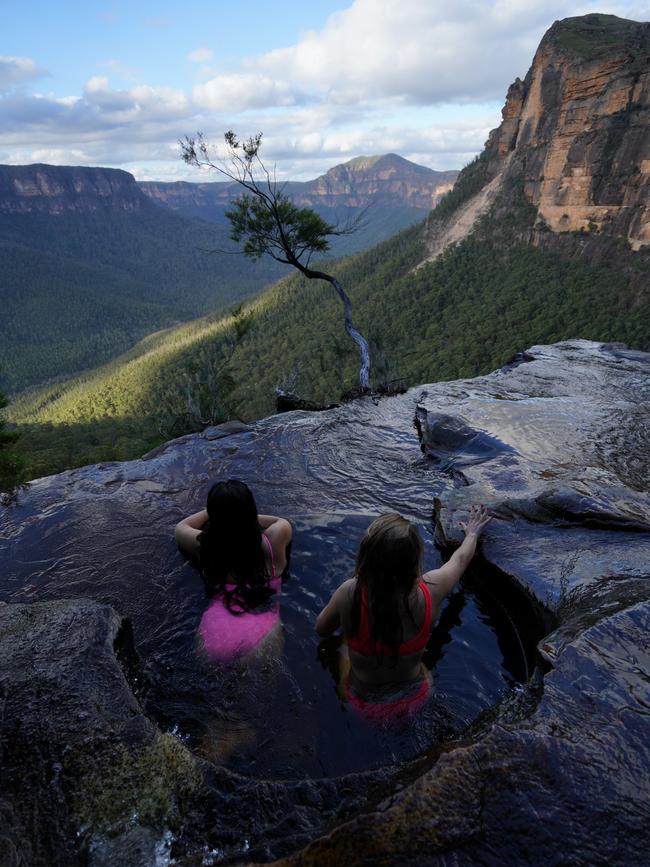
Once obscure tracks, tightly guarded by locals, have been cracked open, as tourists bypass Echo Point and Scenic World for the road less travelled. One cafe and running shoe store owner, hit hard by the fires and pandemic, said they have “lost track of the amount of times we have had to restock the book”.
“They’re brilliant. It’s blown us away. We had heaps of people coming in just to purchase those books,” says Shane Simpson, owner of Blue Mountains Running Co, Glenbrook.
Yet, like the highway that cuts through the mountains, the group divides the community. “You’ve got two types of people,” says long-time Lost Mountains supporter, and close friend, David Smith.
“You’ve got locals who know that the Blue Mountains thrives on tourism. All the businesses up here suffer if there are no tourists. Then you’ve got the other people on the other side that feel that the National Park is theirs. And they don’t want anyone else there. And they don’t want to see anyone else’s footprints.
“They are saving the knowledge of these places. There’s a group of people who would be perfectly happy to put a padlock on our National Park, so it can just be preserved exactly as it is.
“The problem is, that’s not the case. It’s been preserved for people to enjoy. It can be the most beautiful place on earth, but what’s the point if no one has ever seen it?
“I can almost guarantee that those people that want to lock the National Park, they still want to have a key.”
SECRET SOCIETY
Smith is one of the very few peoplewho know the true identity of the group. The group keeps their true identity a closely guarded secret – it takes years of conversations with group founder, George Kaplan (not his real name), to agree to meet Sydney Weekend Magazine in person. When he does, it is with the agreement that his identity be obscured.
“We are about promoting places, not faces,” says Kaplan. “We didn’t want to be continuing on the influencer culture. We wanted it to be about our place, our home, the region.”
On the day Sydney Weekend joins them for a hike, he and two other members of the team, a 15 year old and an ultra runner in her mid 20s agree to take us into the bush.
They pick us up at Katoomba station and we head into the scrub, bypassing brightly marked signs for popular walks. As we clamber down into the canyon, the dense scrub swallowing us whole, the group begins to relax. Slowly, the story behind their anonymous profile comes out.
“We felt like the local stories, folklore, the legends, they were all dying,” Kaplan says.
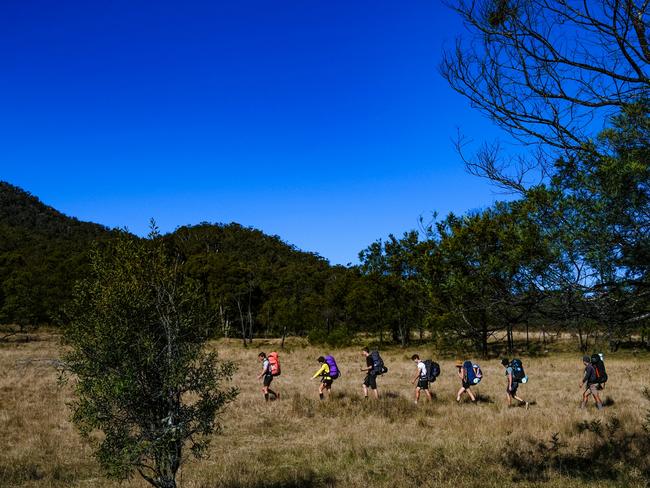
“No one goes out anymore. We needed to do something. The books are designed for beginners, they are designed for people that want to get out of Sydney and have an adventure. People come out here and just go, ‘I don’t know where to go.”
The 15 year old pipes up. The soft-spoken teenager is the youngest member to join the group and, in many ways, is a surrogate younger brother to the team. They watch over him closely, always triple checking his harness and testing him on his safety knowledge.
“It’s also really good for mental health.” Before he joined the group, the teenager was spending his days inside, gaming. His dad, a close friend of Kaplan, reached out and asked if the team would take him on one of their treks. Instead, they invited him to join the team as a junior member. The change in his mental health was dramatic.
“It’s got me occupied with things, instead of sitting inside on my phone,” the teen says. “Most of my friends are just sitting inside or watching movies.”
In many ways, he is living a double life.
“All of my friends follow the group and talk about them. There’s even Lost Mountains stickers all throughout the school. Little do they know, I am actually a part of it. But that’s not to say you need to be a part of the team to get outside. Anyone can buy the book and anyone can go outside.”
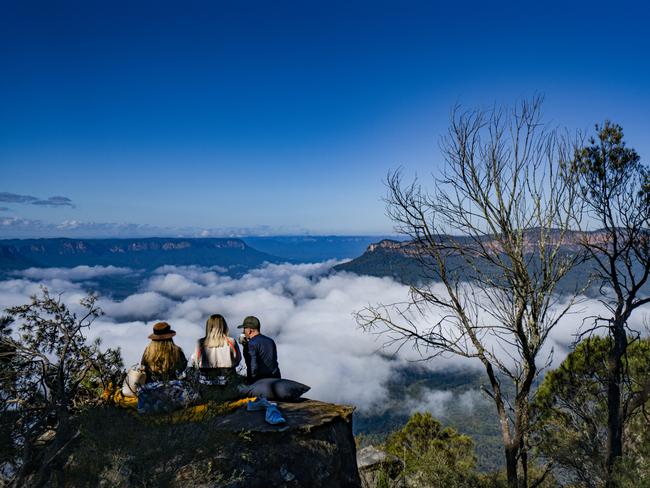
But should every location be shared? Gundungurra man David King, and member of the Gundungurra Aboriginal Heritage Association Incorporated (GAHAI), says that while it is important the Blue Mountains is promoted, the numbers need to be balanced.
“I think it’s great that people want to get people to connect to the country but I think there’s got to be a bit more wisdom in it sometimes. They are so popular. It’s amazing … but being popular doesn’t mean safety,” King says.
“Locals are worried about how it is encouraging (people) to get out to remote sites. It looks like it is just mass numbers … it’s good to get people out there, but do we make it so accessible that it ends up being bad for the country?
“It concerns me that I am not aware of any traditional custodian consultation. They are having a big impact. It would be great to have a cuppa with them, even if it’s in a secret cafe. It’s not to tell anyone off, we just want to care for country.”
The location we are headed to features in the guidebook, but the path is noticeably empty. The only trace that humans were ever here is the footprints we leave behind.
Kaplan comments on the quiet. “I think it is a cop-out saying showing people these places is destroying them. We are trying to advocate getting out into nature, and showing people a safe and easy way to do it.
“We actually don’t share anything that isn’t already online but it is just not widely known. I have been a part of the climbing community and the canyoning community all my life, and they have so many problems with us, but none of them realises I am actually a part of this group.
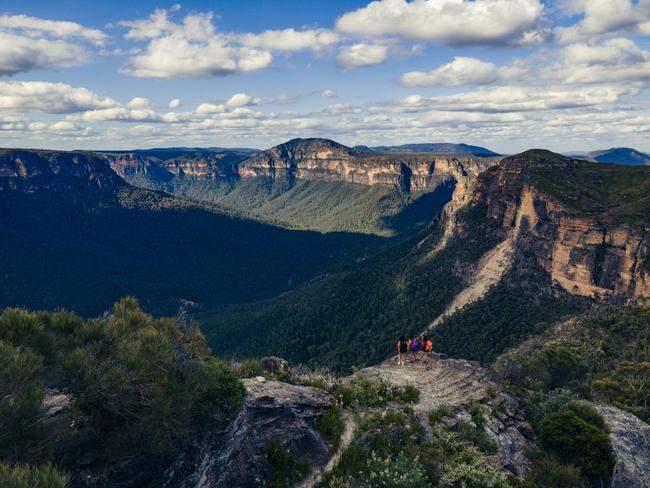
“We would never reveal anything that isn’t already out there.
“We have people write to us saying ‘this place has had so many more people come here since you put this out’, but they forget about all the other social media influencers who share these locations, but say nothing about safety, nothing about taking your rubbish with you, we want to advocate for people getting outside, but we want them to do it safely.”
For many, the greatest criticism of the group has been their approach to safety. Each year around 130 bushwalkers in the Blue Mountains get lost and require rescuing. It’s only due to the hard work of SES and Police Search and Rescue that most return home. Others are swallowed whole by the mountain. In 2021, two women died while canyoning in the Blue Mountains. 39-year-old NSW police officer Senior Constable Kelly Forster and a 24-year-old Chinese international student died after they were pulled into a whirlpool while on a canyoning tour with eight others.
Forster drowned while trying to rescue the young student. In a statement, police rescue said while ‘there is nothing wrong with people going out and exploring nature, all we ask is that people are prepared when trekking into these locations’.
As we stand on top of a cliff, looking out at the endless expanse of eucalyptus trees – responsible for the mountain range’s famous blue tinge – adrenaline pumps through us. And like most cases, this adrenaline comes with a side of fear.
STAY AWAY FROM THE EDGE
“It’s a disaster waiting to happen.” This is the consensus among most local adventure companies in the community. A mention of Lost Mountains in any of the local canyoning stores will trigger a hiss among employees.
“They encourage people to do things that are dangerous or that damage the environment and in a way that’s totally unnecessary,” says adventure store employee Kerensa Cleaver.
“One thing you can see a lot in their videos is that they have people always standing at the edge of cliffs looking out and no tour company would ever encourage you to do that. There’s no need to ever be near a cliff edge and if you are you should be tethered. And so they really just encourage pretty blatant negligence around cliffs. It’s totally taboo, you don’t just go frolicking around cliff edges without a safety on.”
Similar complaints colour local Facebook groups dedicated to rock climbing and canyoning. In one post, a member described having to see a young female in her mid-20s rescued from the infinity pools made famous by the Lost Mountains team.
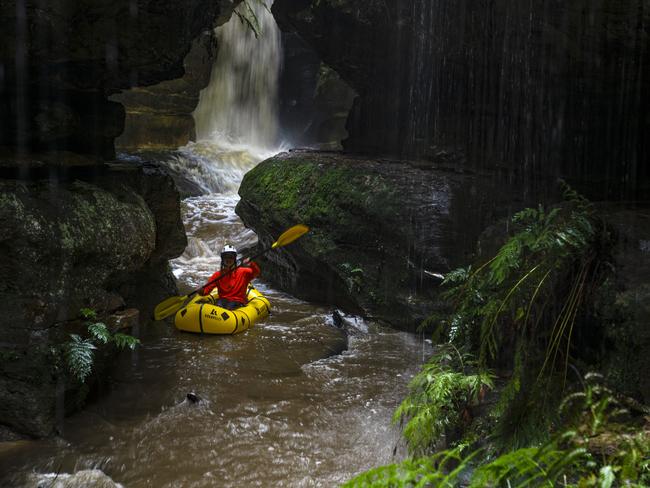
“Just prior to me arriving to the exit track of the Fortress Canyon today, a young female in her mid 20s shattered her knee when she slipped at the infinity pools. None of the parties at the canyon had First Aid or emergency equipment … All of the different (unprepared) groups at Fortress knew of the location from the #lostmtns books.”
When asked about the group, NSW’s National Parks and Wildlife Service said they were aware of Lost Mountains and were ‘concerned about inexperienced and poorly prepared visitors taking part in potentially dangerous activities.’ A spokesperson reminded people there are a number of licensed tour operators offering adventure activities in Blue Mountains National Park.
Yet, for all the group’s Instagram posts, there is no denying the team knows what they are doing. When the camera stops rolling, social media does not see the way the group scuttles back from the ledge, sliding on their bottoms, not daring to stand up and risk toppling over the edge. The way they carefully point out the green algae, warning others of deadly slip spots. Or the way they carefully check and adjust their carabiners, helmets and ropes – the entire team regularly takes part in rope safety courses.
“We never say do something you are not comfortable with. We don’t force anyone to do anything,” Kaplan says.
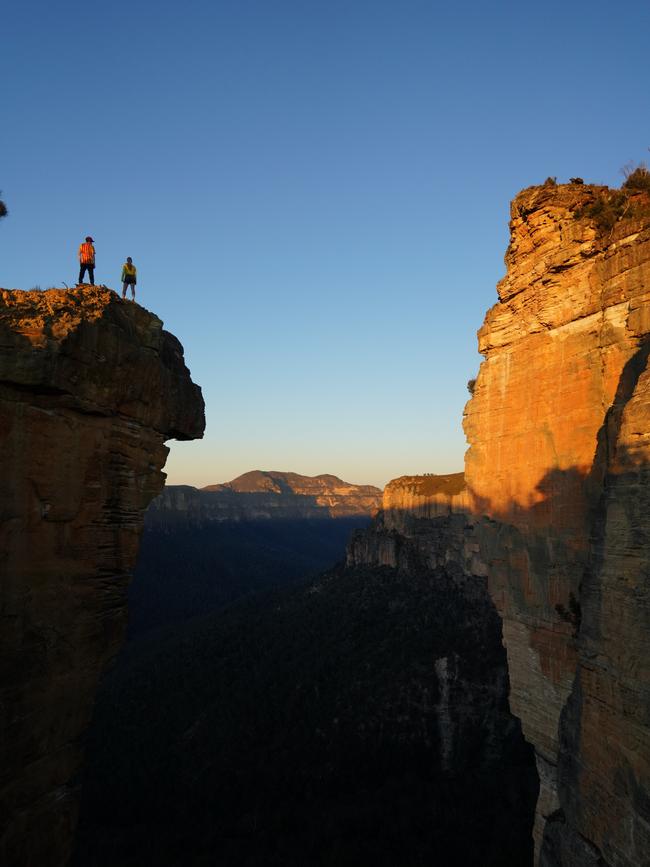
“Education is the biggest thing that is missing right now. Everyone says ‘Get off the couch and go outside’, but no one says ‘Get off and go outside, but don’t forget to pack water, a personal location beacon, don’t forget to look out for snakes, and have a First Aid kit. If you jump from a height, check the water.’ And that’s where we feel we are responsible.”
During the 2019 Black Summer bushfires, Lost Mountains played an important role in the community. At a time when coverage was scarce, fires raging hours ahead of the vital Fires Near Me app, Lost Mountains was there, updating the community on the roads that were still open and those that had succumbed to fire.
A clip of a fire, climbing a sheer rock face, tearing away at the side of the mountain, was shared by news sites across the world. Similarly, during the floods, the team was on the ground, updating people.
“We spent numerous sleepless nights at people’s properties … During the fires we felt like if we saw something happen, we would upload it. We weren’t trying to do clickbait, and we weren’t trying to be a news site, we just wanted to help people,” Kaplan says.
“We got numerous messages from people saying, ‘Thank you so much for sharing this, because I came home immediately – I didn’t realise how close it was.’ Others saying, ‘Thank you so much for encouraging us to evacuate.’”
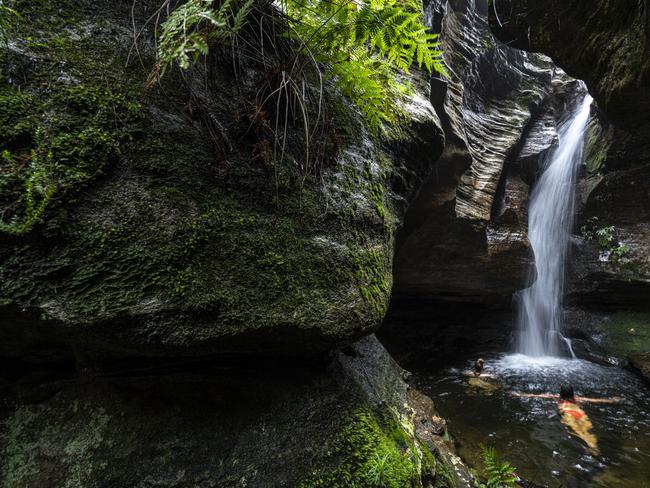
Despite safety criticism, it’s clear the team has many followers who will fiercely defend their safety record. Rachel Minn says her life has been transformed by the group. The western Sydney resident grew up in the city and says she “didn’t know the first thing about the outdoors”. After discovering the group, she’s now decided to eventually move to the mountains permanently.
“When I first started, I was very naive. I had no clue about what I was doing. I just saw pictures (on social media), and I saw something amazing and I told my friend let’s go. We went without water. We didn’t know how long it would take. I did really silly things,” she says. “My friends and I would literally just drive to a spot I found on Instagram and just start walking. We would just go and jump into (waterholes) and not have any idea about underwater rocks. We put ourselves at risk so many times. People are going to find these places regardless, these books not only help them safely get there, but also help them be prepared.’’
As we sit above the cliff top, looking out over the expansive canyon, the group falls into a comfortable silence. Nature washes over us and our aching muscles remind us we are becoming stronger. Kaplan takes a photo of our legs, hanging over the edge and smiles. “Whatever the haters say, we’re definitely here to stay.”



